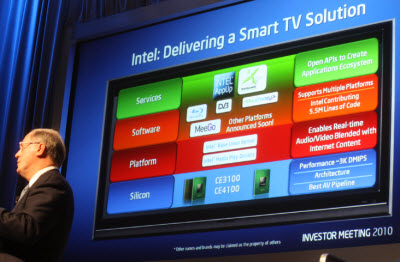
This year’s models of web-connected TV sets come with about 10 million lines of software code, about 10 times the amount in older TVs. Those new TVs have about triple the computing performance of the older TVs, according to Paul Otellini, chief executive of Intel, speaking at the company’s analyst meeting today.
[aditude-amp id="flyingcarpet" targeting='{"env":"staging","page_type":"article","post_id":182255,"post_type":"story","post_chan":"none","tags":null,"ai":false,"category":"none","all_categories":"business,","session":"D"}']The same is happening to all sorts of gadgets, from car navigation devices to smartphones, from home energy management systems to digital signs in stores. Dumb things are getting smarter. That means they will become platforms for ever-changing services and apps.
AI Weekly
The must-read newsletter for AI and Big Data industry written by Khari Johnson, Kyle Wiggers, and Seth Colaner.
Included with VentureBeat Insider and VentureBeat VIP memberships.
To succeed, Intel will have to take market share away from the leading low-power microprocessor design firm, ARM, and its many licensees that design chips using ARM’s basic architecture. While Intel has shipped 3.3 billion cores (or computing brains, with multiple cores on a chip these days) during its history, ARM licensees ship multiple billions of chips per year already, thanks to their use as the primary brains in cell phones.
Intel has launched a big software development training program for the Atom chips. Since the launch of the original Atom chips a few years ago, there are more than 240,000 programmers working on code related to Atom processors, said Renee James, head of software at Intel. Otellini said, “Anyone who wants to compete with us here will have to do software.”
Intel is gearing up for a massive retail product and service launch this year, Kim said, but he declined further comment on that.
“This convergence of computing and TV has been talked about since early 1990s, but it hasn’t happened,” Kim said. “Today, when you go to the store, you can see many TVs and Blu-ray players that have internet connections. We think that TV is the next major frontier of inovation.”
[aditude-amp id="medium1" targeting='{"env":"staging","page_type":"article","post_id":182255,"post_type":"story","post_chan":"none","tags":null,"ai":false,"category":"none","all_categories":"business,","session":"D"}']
VentureBeat's mission is to be a digital town square for technical decision-makers to gain knowledge about transformative enterprise technology and transact. Learn More
